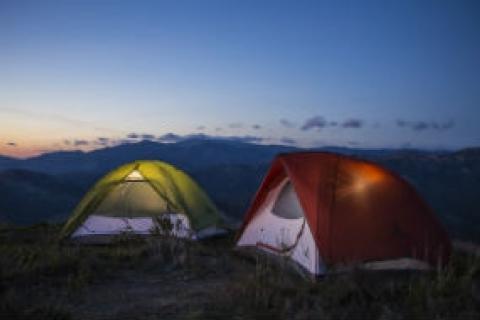

For some campers, a good night sleep is easily achieved after a day of adventure taxes the body. But for others, even a day of trail trekking or kayak paddling can't bring a comfortable slumber experience. Laying your head down in a strange place can disturb the sleep routine, but if a few adjustments in bedding and sleep preparation at camp are made, a good night's sleep is possible.
The foundation of a comfortable camp bed is the padding and/or bed apparatus. Most tent campers use sleeping pads of various styles, some of which may not be the best choice for every camper. Trial runs with a couple pad styles will reveal which is the best for you. Each sleeping pad style has its pros and cons for various camping situations. If camping with family or friends, consider trading sleep pads for one night for comparison.
Self-inflating pads provide excellent insulation from the cold ground. A valve is opened and entering air expands the pad. Cons are that a puncture can occur and the initial cost is more than other sleeping pads. A foam-type pad is more economical but is more bulky when packing for travel. Foam pads are also excellent insulators from the cold ground.
Air mattresses have gained popularity among the car camping crowd, primarily because of the extra comfort gained. The comfort comes with a bit more time and effort in inflating the mattress, although, the use of a motorized air pump handles the task within a minute or two. Air mattresses should not be used during colder weather as the air in the mattress doesn't provide insulation to the cold.
The most comfortable camping bed is a cot. These are great if space in the tent exists and if the cot doesn't take up too much space in the vehicle when packed for the trip. A cot keeps the camper off of the ground, dry if the tent would happen to leak rain, and allows older campers to rise more easily in the morning.
A sleeping bag is the icing on the camp bedding cake, but packing an extra blanket adds more comfort if needed.
Additional Tips for Comfort
With the padding and sleeping bag squared away, let's consider a few additional options to improve the odds of a good sleep at camp.
Before sliding into the sleeping bag, change into clean clothes. Dirty or sweaty clothes not only lead to creating a smelly sleeping bag, they cause discomfort to the skin. If the night air temps are radical compared to the day's temps, dress warm, or cooler, to handle the temperature range. Add a beanie or stocking cap to the camp clothes list. A separate one for use only during sleep to keep it clean. A pillow can also make or break your camp nap, by keeping from waking with a stiff neck.
To save packing space, roll up a clean shirt in a pair of pants to serve as a pillow. If camping near others, try ear plugs and an eye mask to block waking sounds and loose beams of light from flashlights. Also keep that in mind when you are the one making noise or shining your flashlight around the campsite looking for the fury critter roaming around your tent.
- 3694 views

